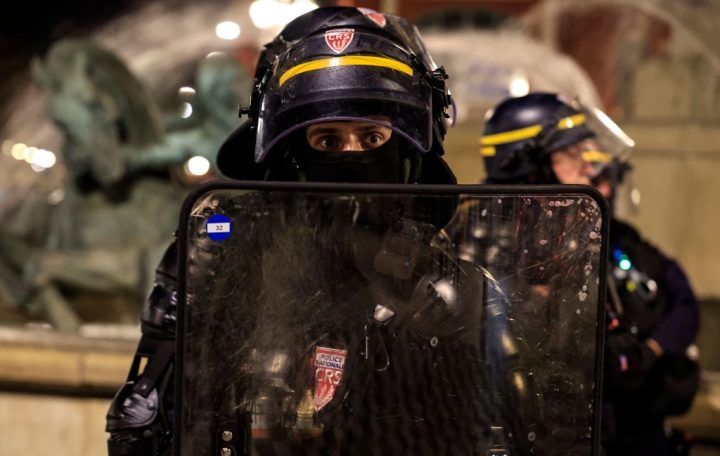There is a myth of France, specifically of its banlieues, that has been frequently repeated in recent days. Descriptions of ‘marginalised suburbs’, ‘ghetto-like suburban estates’ and of ethnic minorities ‘shunted away into suburban housing projects…out of sight and out of mind’ have emerged in the international media. It’s even been suggested in one British publication that rising food prices were to blame for the riots.
Nanterre, where 17-year-old Nahel was shot dead by a policeman eight days ago, has some tough estates but it not a ghetto abandoned by the French state. The housing estate where Nahel lived was built in the late 1970s and at the time was considered ‘an emblematic project of democratic urban planning’. In February this year it was announced that the estate would be among those neighbourhoods to be renovated as part of a €112 million (£95.6 million) urban development project. Such projects are not uncommon in France.
The riots have ended, for the time being at least, but the divisions in France run deeper than ever
Since the formation of the National Agency for Urban Renovation (ANRU) in 2003, some €48.4 billion (£41.5 billion) has been invested into 700 neighbourhoods where five million people live. What many rural districts, where public transport and health services have steadily deteriorated this century, wouldn’t give for such a sum. Resentment appears to be growing; a poll this week revealed that 48 per cent of the French are opposed to more money being funnelled towards inner city projects.
Nanterre is one of 36 communes that comprise the Hauts-de-Seine Department. I live in one, seven miles south of Nanterre. Last year, Le Figaro rated the communes using several criteria such as security, health services, sports facilities and environment. Mine was ranked 18th out of 36, Nanterre was 32nd, Meudon was ninth and Puteaux tenth.
All of these communes except mine were subjected to appalling violence last week. I have no idea why my district was spared; from my window I heard the sound of trouble from the neighbouring commune of Clamart, which has just emerged from a four day curfew imposed by the mayor after thugs burned a tram.
Nanterre, Clamart, Meudon and Puteaux are not marginalised or abandoned; they, like my commune, have good services including the free use of football pitches, basketball courts and running tracks. The sports facilities at the end of my road are always busy with young people of all ethnicities blowing off steam.
Approximately 4,000 people have been arrested during the rioting and some are now being brought to court. On Tuesday Gerald Darmanin, the Minister of the Interior, issued a rebuttal to some right-wing politicians who claimed that much of the trouble was the work of illegal immigrants; less than ten percent of those arrested are foreign.
Many of the looters appear to be opportunistic idiots who lost control of themselves in the carnival of destruction. On Sunday twelve young men appeared in a Grenoble court to answer charges of looting. Among them was a builder, two fast-food workers, a student and an apprentice for an electrical engineering firm. Three of the defendants were from North Africa and in the country illegally. Asked why they had participated in the riots, only two of the twelve cited the death of Nahel as the reason.
Those responsible for more serious crimes – such as the 6,000 vehicles torched, the 1,100 buildings damaged, the 270 police stations attacked and the 800 police officers wounded – have a different profile. According to the French intelligence service they fall into three categories: young men from the inner cities with a long history of confronting the police; veteran far-left extremists ‘driven by the logic of chaos’, and a third group, described by the intelligence service as ‘clueless’: the immature middle-class youth who turns up at any protest against the government.
In Toulouse there have been reports that members of the ‘black bloc’, the nebulous protest movement, have been active during the riots. Far-left extremists are also accused of being present in the Brittany city of Brest. On Tuesday several far-left activists shouting anti-police slogans disrupted the trial of some alleged rioters in a Lyon court.
Perhaps this is no surprise. In the past week many politicians from Jean-Luc Melenchon’s La France insoumise [LFI] refused to condemn the violence, a stance which has caused divisions among more moderate members of the left-wing parliamentary coalition. On Tuesday Prime Minister Elisabeth Borne said she was ‘very shocked’ by some of the LFI rhetoric in the past week, an attitude shared by the majority of the public in a poll published on Monday.
They named Marine Le Pen as the politician who has emerged strongest from the events of the past week with Melenchon the most damaged. According to the political scientist Benjamin Morel, Le Pen and her 87 National Rally MPs have deliberately kept a low profile during the mayhem, avoiding inflammatory remarks and cultivating an air of Republican gravitas. ‘The National Rally is aiming for credibility,’ said Morel. ‘A strategy that seems to be paying off.’
The other noteworthy fact to emerge from the poll was that 57 per cent of people canvassed still had complete faith in the police; another survey found that 89 per cent of respondents condemned the violence against the police.
Some of these respondents of these polls may well have contributed to an online fundraising platform that in a few days collected more than €1.5 million (£1.3 million) for the family of the officer charged with shooting Nahel. A similar fundraiser for the family of the dead teenager stands at €350,000 (£300,000).
The amount collected for the police officer’s family angered some on the left and embarrassed the government, but it is a further indication where lie the loyalty of the silent majority. The riots have ended, for the time being at least, but the divisions in France run deeper than ever.







Comments